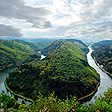CASTLE ELTZ
Knights Castle of the Mosel Valley
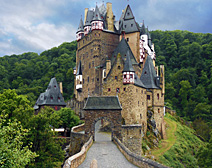 Eltz Castle (Burg Eltz) has one of the most unique profiles of castles, a tall cluster tower of capped turrets, in the form of construction called "Randhausburg", a circular walled fortress residence around a courtyard, and has the distinction of being one of the very few medieval castles in the region west of the Rhine to have not been destroyed in war and to survive in much of its original form, at least since the 14th Century. Visually striking and solitary in its verdant valley, the castle has often been mentioned as a favorite among travelers and castle lovers.
Eltz Castle (Burg Eltz) has one of the most unique profiles of castles, a tall cluster tower of capped turrets, in the form of construction called "Randhausburg", a circular walled fortress residence around a courtyard, and has the distinction of being one of the very few medieval castles in the region west of the Rhine to have not been destroyed in war and to survive in much of its original form, at least since the 14th Century. Visually striking and solitary in its verdant valley, the castle has often been mentioned as a favorite among travelers and castle lovers.
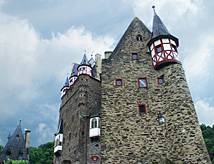 The Castle of Eltz, dating from the age of the Stauffer kings of the 12th Century has remained in the same family for over 850 years until the present. The first mention of a castle at Eltz was in a deed issued in 1157 by the German Holy Roman Emperor Frederick Barbarossa (see Kaiserswerth Imperial Ruins), witnessed by Rudolf von Eltz. At the time, Rudolf held a small castle next to the Eltzbach, the hillside range of protecting mountains along the north banks of the Mosel River. This was an important trade route from the imperial city of Trier along the river to the fertile farmlands of Maifeld and the road to Koblenz. Parts of the earliest castle, the Romanesque era keep Platt-Eltz and four floors of the living quarters, can still be seen, with one of the oldest painted chimneys in Germany.
The Castle of Eltz, dating from the age of the Stauffer kings of the 12th Century has remained in the same family for over 850 years until the present. The first mention of a castle at Eltz was in a deed issued in 1157 by the German Holy Roman Emperor Frederick Barbarossa (see Kaiserswerth Imperial Ruins), witnessed by Rudolf von Eltz. At the time, Rudolf held a small castle next to the Eltzbach, the hillside range of protecting mountains along the north banks of the Mosel River. This was an important trade route from the imperial city of Trier along the river to the fertile farmlands of Maifeld and the road to Koblenz. Parts of the earliest castle, the Romanesque era keep Platt-Eltz and four floors of the living quarters, can still be seen, with one of the oldest painted chimneys in Germany.
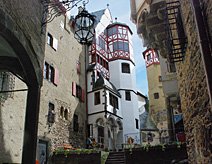 The Burg Eltz castle is also curious in that it housed three branches of the same family in different sections of the castle. In 1268, three von Eltz brothers had a dispute over inheritance and the family split into three hereditary lines. They divided the estate, but remained in the same fortress, a familial “Ganerbenburg”. The castle at that time had fortifying defence walls. The tower keep to the north of the main keep called the "Klein Rodendorf" was built by Theodore zu Eltz between 1290 and 1300 for his family line identified by the heraldic “Buffalo Horns”, while not to be outdone, Johann zu Eltz, the son of second brother Wilhelm, built the five stories of the tower called the "Rübenach House" about 1326, for his line of the family “the White Lion”.
The Burg Eltz castle is also curious in that it housed three branches of the same family in different sections of the castle. In 1268, three von Eltz brothers had a dispute over inheritance and the family split into three hereditary lines. They divided the estate, but remained in the same fortress, a familial “Ganerbenburg”. The castle at that time had fortifying defence walls. The tower keep to the north of the main keep called the "Klein Rodendorf" was built by Theodore zu Eltz between 1290 and 1300 for his family line identified by the heraldic “Buffalo Horns”, while not to be outdone, Johann zu Eltz, the son of second brother Wilhelm, built the five stories of the tower called the "Rübenach House" about 1326, for his line of the family “the White Lion”.
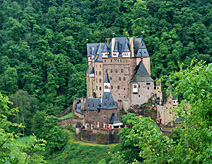 Then in 1331 came the main dispute which shaped the castle in its present form. The Eltz families formed an alliance with their neighboring castle lords of the Eltzbach (see Burg Pyrmont) in a confrontation with the Archbishop-Elector of Trier, the Burgundian Balduin (Baldwin) of Luxemburg, the brother of the Emperor Henry VII, who was consolidating his control over the region and the dioceses of Worms and Speyer (see Speyer Cathedral). In what came to be called the “Eltz Feud”, Balduin laid siege to the Eltz Castle,, building a fortified attack position on a nearby hillside where he launched stones and catapaults at the Eltz fortress, and ultimately an early cannon assault, the first documented cannon fire north of the Alps. The siege lasted for nearly five years, until the Eltz knights finally capitulated in 1336, when the fortification walls were demolished, leaving a fortified residence, with construction and additions continued for another 500 years.
Then in 1331 came the main dispute which shaped the castle in its present form. The Eltz families formed an alliance with their neighboring castle lords of the Eltzbach (see Burg Pyrmont) in a confrontation with the Archbishop-Elector of Trier, the Burgundian Balduin (Baldwin) of Luxemburg, the brother of the Emperor Henry VII, who was consolidating his control over the region and the dioceses of Worms and Speyer (see Speyer Cathedral). In what came to be called the “Eltz Feud”, Balduin laid siege to the Eltz Castle,, building a fortified attack position on a nearby hillside where he launched stones and catapaults at the Eltz fortress, and ultimately an early cannon assault, the first documented cannon fire north of the Alps. The siege lasted for nearly five years, until the Eltz knights finally capitulated in 1336, when the fortification walls were demolished, leaving a fortified residence, with construction and additions continued for another 500 years.
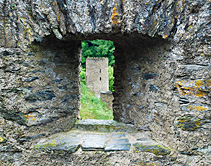 The top stories and the roof of the Rübenach House were added in 1442, with the staircase completed in 1444. The large Rodendorf House was built between 1470 and 1520. The Banner Hall in this part of the castle dates from 1470 with a magnificent late-Gothic vault ceiling, once probably part of a chapel. Four more floors of residence were added above in the 16th Century when Hans Adolf zu Eltz married Katharine von Brandscheid zu Rodendorf in 1563, forming the Eltz-Rodendorf branch, allied with Lorraine, France (see Dukes of Lorraine Moselle). From this period through the 17th Century, the family reached their greatest influence as Electors of Mainz and Trier as counter-reformation Catholics. Their power lasted until Philipp Karl zu Eltz. Prince Elector of Mainz (see Johannisburg Palace Aschauffenburg) got caught on the wrong side of power struggle between the Habsburgs of Austria and the Wittelsbachs of Bavaria (see Bavarian Residence Palace) for the Imperial Crown in 1742.
The top stories and the roof of the Rübenach House were added in 1442, with the staircase completed in 1444. The large Rodendorf House was built between 1470 and 1520. The Banner Hall in this part of the castle dates from 1470 with a magnificent late-Gothic vault ceiling, once probably part of a chapel. Four more floors of residence were added above in the 16th Century when Hans Adolf zu Eltz married Katharine von Brandscheid zu Rodendorf in 1563, forming the Eltz-Rodendorf branch, allied with Lorraine, France (see Dukes of Lorraine Moselle). From this period through the 17th Century, the family reached their greatest influence as Electors of Mainz and Trier as counter-reformation Catholics. Their power lasted until Philipp Karl zu Eltz. Prince Elector of Mainz (see Johannisburg Palace Aschauffenburg) got caught on the wrong side of power struggle between the Habsburgs of Austria and the Wittelsbachs of Bavaria (see Bavarian Residence Palace) for the Imperial Crown in 1742.
The castle was fortunate to escape the damage other castles suffered during the 30 Years War of Palatine Succession, when the Catholic French houses were competing the German Protestants for control of central Europe, a conflict which laid ruin to many of the castles of the Rhine lands (see Castle Frankenstein Rhineland). The Eltz Castle was saved due to the influence of a family member, Hans Anton zu Eltz-Üttingen who was serving as a high ranking officer with the French, and had the ancestral castle removed from a list of fortresses to be destroyed, while an impromptu raid by a French scavenger squadron moving through the valley was thwarted by the villagers of nearby Müden, who diverted the soldiers into a field of drying corn and set it ablaze.
Burg Eltz Tour
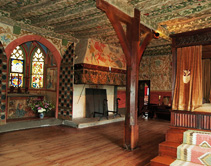 A tour of the castle leads through a number of the more impressive rooms. The entrance hall of the Rübenach House was converted into an armory and displays the oldest surviving cannon bolts, thrusting weapons and firearms. The Lower Hall was the living room of the Eltz-Rübenach family. It was built in 1326 and houses the famous masterpiece by Lucas Cranach the Elder of "Madonna with Child and Grapes". The Upper Hall with its wall murals, intricate Gothic chapel Oriel and colourfully illustrated windows is also called the Bed Chamber for the large carved four-poster bed. Above the entrance, Count Karl von Eltz made a study for his wife in the 1881 romantic revival period. The murals by E. Knackfuß depict Gothic vines framing portraits of Karl with romanticised medieval images of his sons and daughters.
A tour of the castle leads through a number of the more impressive rooms. The entrance hall of the Rübenach House was converted into an armory and displays the oldest surviving cannon bolts, thrusting weapons and firearms. The Lower Hall was the living room of the Eltz-Rübenach family. It was built in 1326 and houses the famous masterpiece by Lucas Cranach the Elder of "Madonna with Child and Grapes". The Upper Hall with its wall murals, intricate Gothic chapel Oriel and colourfully illustrated windows is also called the Bed Chamber for the large carved four-poster bed. Above the entrance, Count Karl von Eltz made a study for his wife in the 1881 romantic revival period. The murals by E. Knackfuß depict Gothic vines framing portraits of Karl with romanticised medieval images of his sons and daughters.
The Elector’s Room is named for the two prince electors (Fürsten) from the house of Eltz, Jakob zu Eltz of Trier (1567-1581) and Philipp Carl zu Eltz of Mainz (1732-1743). Its original furnishings document the stylistic developments during the 17th and 18th century and the Knight’s Hall is a late medieval construction of the early 16th century with an original heavy oak ceiling and the heraldic wall frieze, now decorated with suits of armour. The Hunting Room contains hunting trophies, elegant hunting weapons, furniture with fine intarsia and an old embrasure dating from the construction period of the castle. The Countess’ Room is also called the Children’s Room for the paintings of children and young members of the House of Eltz. The room features one of the oldest surviving painted Renaissance beds in Germany, from around 1520. The Banner Hall from about 1480 with its late Gothic vault ceiling is the most spectacular room in the castle, believed to be a chapel originally, later converted to living and dining room for the Rodendorf line. Before departing the tour exits the 15th century kitchen, one of originally four kitchens in the castle serving the different families.
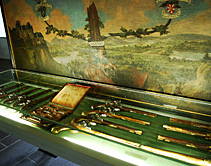 The Eltz Castle Treasury is separate from the guided tour and comprises an important collection with more than 500 exhibits from eight centuries of the Eltz families’ history. The exhibition focuses on artworks by German gold and silver smiths, especially from Augsburg and Nuremberg, precious glass and porcelain, jewelry and weapons collection, some ceremonial.
The Eltz Castle Treasury is separate from the guided tour and comprises an important collection with more than 500 exhibits from eight centuries of the Eltz families’ history. The exhibition focuses on artworks by German gold and silver smiths, especially from Augsburg and Nuremberg, precious glass and porcelain, jewelry and weapons collection, some ceremonial.
Visiting Castle Eltz
The castle is open daily from 9:30 am to 5:30 pm, from the last weekend of March to first weekend of November. The guided tours begin every 10 to 15 minutes and take about 35 to 40 minutes. Admission is €9 for adults, €6.50 Students and Disabled, with group reductions and a Family Ticket for €26. The Treasury can be visited without a guide by showing a valid ticket, open until 6 pm. The exhibits are labelled in German by English translation text is provided in a pamphlet. There are two self-service restaurants in the outer castle, with indoor cozy seating or outdoor terrace Parking for the castle is €4, with a shuttle bus for €2. The castle is reached by road from Münstermaifeld and Wierschem. By cruise boat on the Mosel from Moselkern or Treis-Karden, by foot hike or taxi. A castle bus runs on the weekends. © Bargain Travel Europe
Find best hotel and vacation deals in the Rhineland
Web Info
Burg Eltz
These articles are copyrighted and the sole property of Bargain Travel Europe and WLPV, LLC. and may not be copied or reprinted without permission.
See Also:
COCHEM’S REICHSBURG ON THE MOSELRHINE CASTLE HOTEL RHEINFELS - ST GOAR

